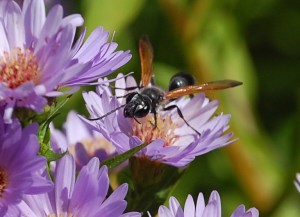With IPM, half the battle is knowing what not to kill. After all, sometimes a beneficial could look like a pest. That’s why an accurate ID is so important. Case in point? The grass-carrying wasp.
At about ¾ inch, these shiny black wasps with the smoky wings and almost impossibly narrow waists look just a little scary. And yes, you might be tempted to run for the spray. But we are not their prey. Instead, they help pollinate flowers. Only if you try to handle them would these wasps ever sting you.

But their main task in life? Building nests — of grass, no less — then paralyzing tree crickets or the occasional katydid, tugging them into those grassy wads, and laying their eggs close by. Then it’s off to sup on some flower nectar among your posies. Each nest is the work of just one female — no worker caste, no helpful male schlepping prey to the nest. Presumably males spend their days cavorting among the flowers.
Once hatched, the larvae feed on those paralyzed crickets. In less than a week they’re ready to pupate. Two or three weeks later the adult wasps break free of their cocoons and fly away. Their first stop? Maybe to tank up back among the flowers on your windowsill and spread some pollen around.
You might see these wasps wafting along on a breeze, each female trailing a long, slender blade of grass trailing behind her to the nest she’s building. But you’re just as likely to discover, much later in the season, that you’d cohabited with a female wasp and her offspring. As did I. I was out scraping old, peeled paint from old, peeling window frames to prepare for some primer and then a fresh coat of paint. On one frame the paint was bulging out, almost like a paint balloon.

And as one long strip fell to the ground I saw grass-carrying wasp cocoons, yes, but also the pupal cases left behind by hatchling flies. Probably it was the fragrance of fresh-cut grass (flies do lay eggs in decaying grass clippings) that attracted them.
In your case, you might’ve removed window screens from their tracks so you could put up the storm windows. Or maybe you just wanted the screens out so you could clean the glass for a better view of the cardinals at your birdfeeder. You might even spy a nest half-hidden in a broken branch now that the leaves have fallen. And wonder at the diminutive black beauty (because if any wasp deserves the name, surely this one does) you unknowingly sheltered, back in an almost forgotten summer.
Meanwhile, go ahead and toss that wad of dry grass aside. No one will claim it next year.